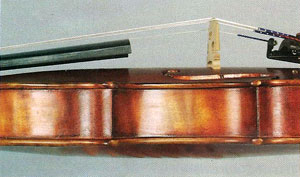This article was published in the June 2010 issue of All Things Strings.
Though often overlooked, the little piece of cord or wire connecting the tailpiece to the end button of your instrument can have a significant impact on sound and playability. 
As with tailpieces, there is no “one size fits all” solution for every instrument and player, but having a variety of models and materials to choose from gives instrument makers and players more “tools in the toolbox” and greater possibilities for adjustment and tonal improvements.
Material Advantage
Throughout most of violin history, a gut cord was usually used to attach the tailpiece to the end of an instrument — hence the term “tailgut.” Wire also has been used for centuries, but whether this was done for tonal effect or to avoid breaking the tailgut is hard to know. There are significant disadvantages to gut, so, in modern instrument setup, nylon, wire, braided wire, and recently Kevlar have superseded gut for the most part.
One disadvantage to a gut tailpiece hanger is that it can be difficult and time-consuming to adjust. The length of a string from the bridge to the tailpiece, called the after length, is determined by tuning one of the strings to a particular for an optimal sound. (Envision having to tune your strings by tying a knot!) Gut is affected by excessive humidity or dryness, so it can still get out of adjustment even when tied to the correct length. Sweat can also make the gut brittle, causing the gut cord to break.
There are players and violinmakers who believe that a gut tailpiece hanger, being soft and flexible, will allow the bridge and tailpiece greater freedom of movement and will add to an instrument’s warmth and tonal color. Others dispute this assertion. Gut may have a desirable or undesirable effect on a particular instrument, but given its unreliability, it may be easier to consider other modern options.
A wire tailpiece hanger is also more tedious to adjust, but wire hanger creates a more rigid connection system than gut. This may or may not be advantageous, but used in the appropriate situation a wire tailpiece hanger may make an instrument more intense and focused, and also feel tighter under the bow and fingers.
The Sacconni Adjuster
In the last 1950s, the great violinmaker and restorer Simone Sacconni found that a tailpiece hanger made of nylon was stronger than gut and held up better over time. His colleague, Frank Passa, came up with the innovative idea of cutting threads on the end of the nylon cord so that a nut could be screwed on the ends of the cord. This greatly facilitated making minute, accurate adjustments.
The resulting Sacconi adjuster is somewhat soft and springy, like gut, and has a tonal effect that is similar to gut, but is much stronger and lasts far longer. This model came to dominate the market and, for a time, its use was almost universal.
New cord materials
One interesting and exciting new development is a braided-wire tailcord with threaded ends, combining the tonal benefits of a wire hanger (more rigidity) with the easy adjustment of a Sacconi adjuster. Another new development is a tailcord made from strands of Kevlar sheathed by braided neylon. The Kevlar cord will not stretch under string tension and has tonal effects similar to braided-wire: potentially quickening the instrument’s response, tightening its feel under the bow, and increasing its intensity. Many players feel that it tends to make an instrument sound more open and full, at least in a small space. Kevlar, like old-fashioned gut, must be tied with knots, but as it is fairly supple, adjustments become easier with practice.
Saddle height must be right
Saddle height is important to consider when adjusting or changing tailpiece hangers.
Looking at a violin from the side, you can see that the angle of the strings from the bridge to the saddle is steeper than the angle from the bridge to the nut. As a result, there is more force pulling the bridge forward toward the nut than backward toward the saddle.
Raising a too-low saddle can bring these forces closer into balance, allowing the bridge and tailpiece greater freedom of movement, resulting in an instrument that rings louder and longer with more sympathetic vibration. It can also lessen the effect of wolf tones.
Adjusting the alignment
The great classical violinmakers — while perhaps allowing a fair amount of freedom and asymmetry in their instruments — went to great lengths to ensure that the neck, upper lobes, of the f-holes, bridge, and tailpiece were all straight and aligned on the center of the instrument. Proper alignment allows for the greatest freedom of movement and contributes to a bigger, fuller, more ringing tone. An instrument that is out of alignment will be uneven, choked and tight-sounding.
Proper alignment should be taken care of during the making or restoration of an instrument, but in many cases it is possibly to correct an out-of-alignment instrument by moving the tailpiece hanger to the brass or treble side of the saddle. This brings the neck, bridge, and tailpiece closer to a straight line and gives the instrument a bigger, more even tone.
In extreme cases, moving the end button is a better solution.